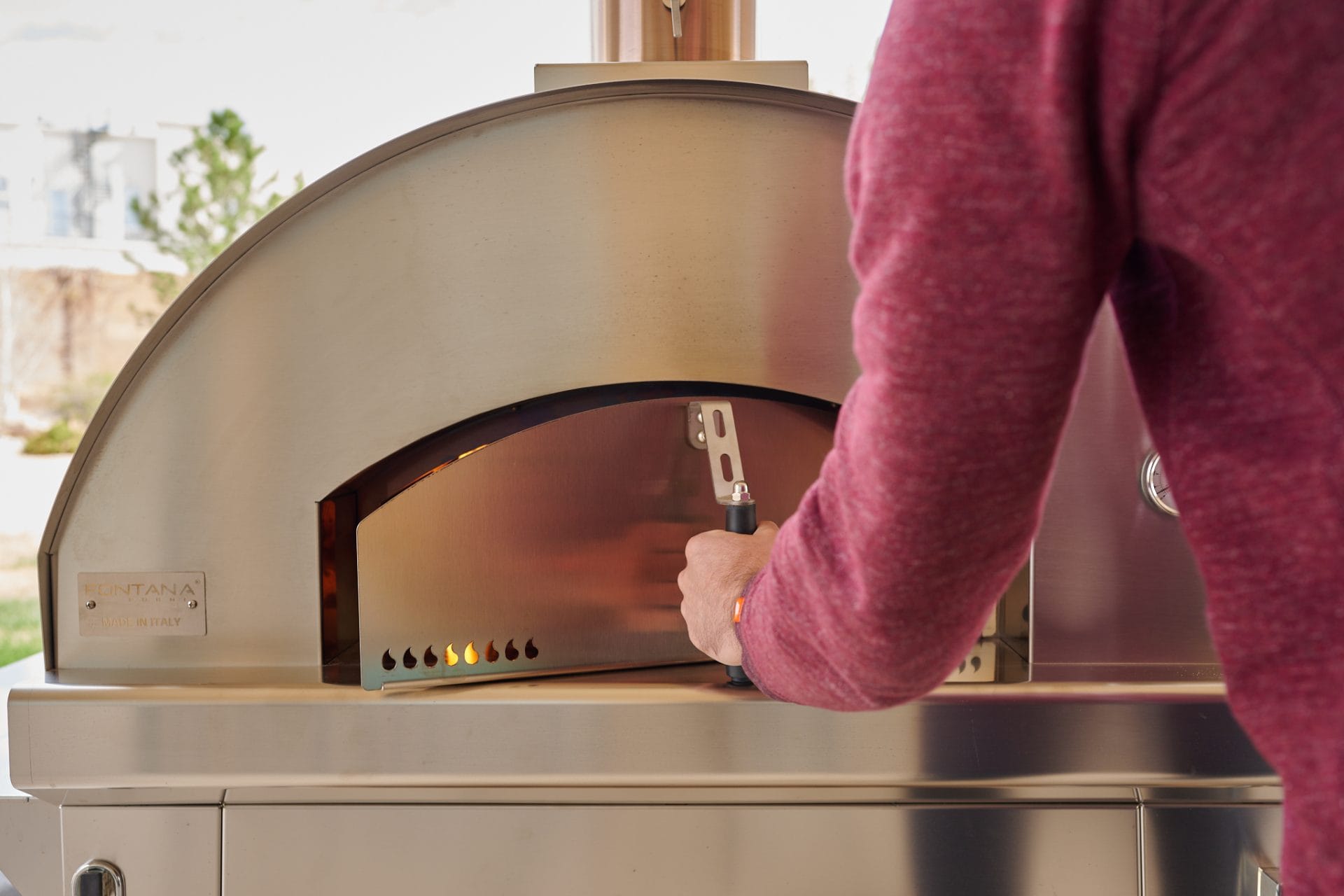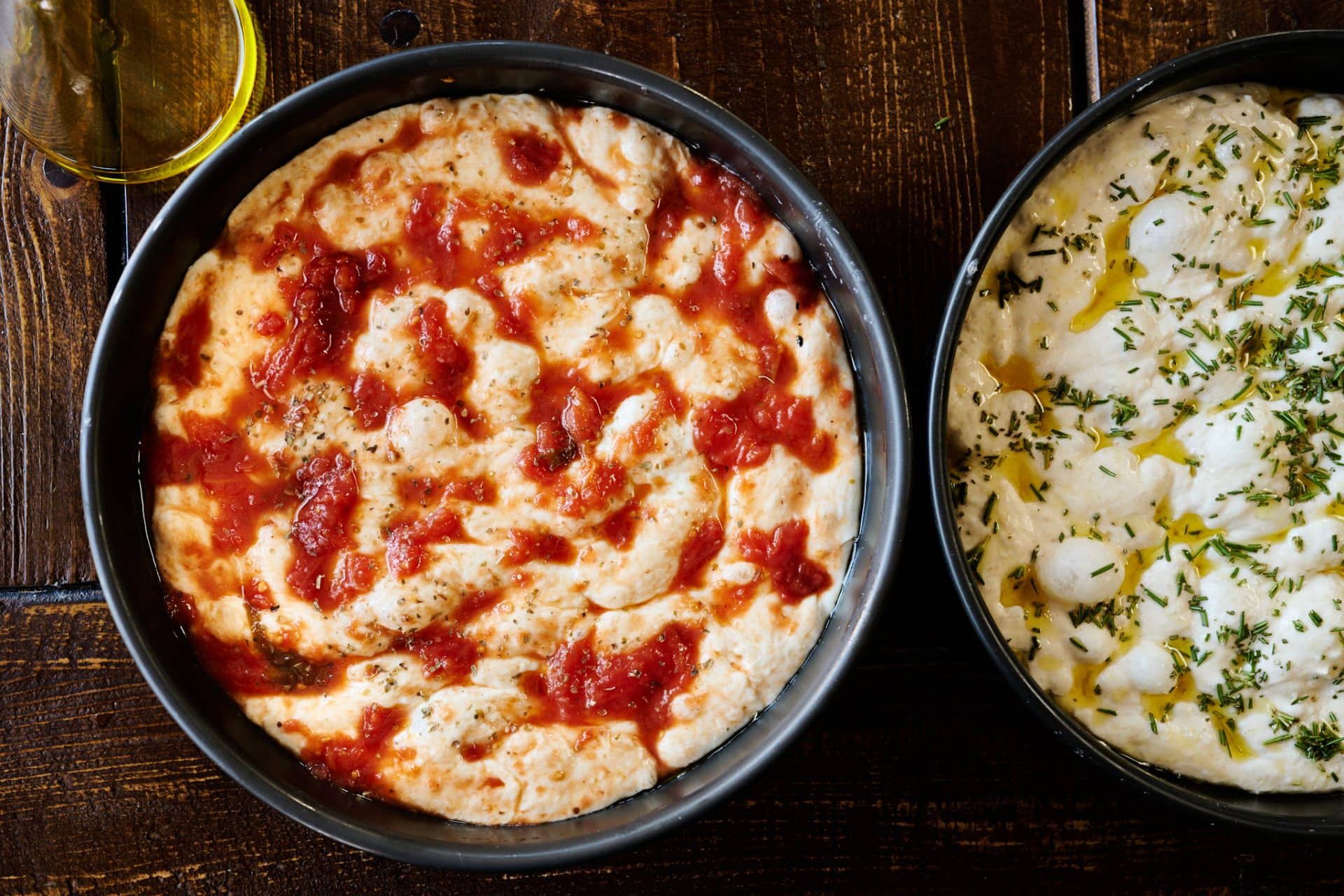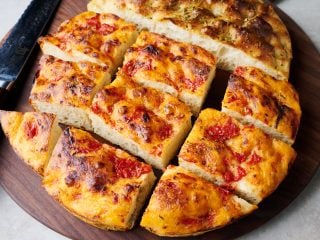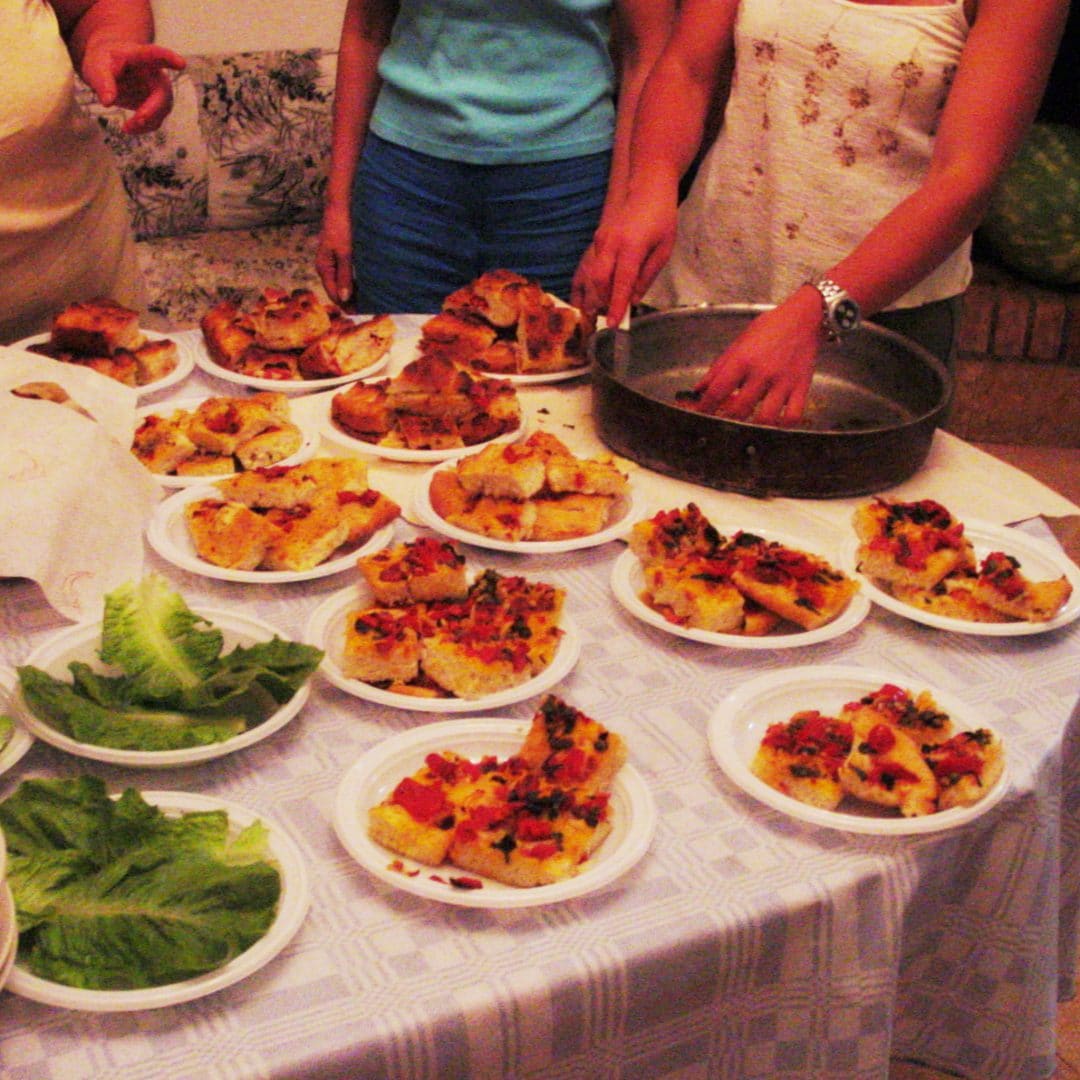Focaccia–a classic Italian flatbread–is interwoven with memories of my childhood (see the image at right, focaccia made for one of my large family gatherings in Ceglie, around 2003). Trips to southern Italy always included at least one stop at the local baker for a large slab of this chewy, savory bread that would keep us well-fed for days. But it’s also something I’d often have at my dad’s restaurant back home, a “special” that would often find its way to the menu, and believe me, on those days I made sure I showed up. While he never explicitly labeled his creations as focaccia Pugliese, even though his side of the family hails from the Puglia region of Italy, I feel like they were in that vein.
Focaccia Pugliese (also sometimes called focaccia Barese) is a style of this flatbread that’s from southern Italy and typically calls for potato added into the dough that’s also commonly topped with tomatoes. My take on it utilizes natural leavening, of course, and follows suit with the incorporation of a large percentage of cooked potato into the dough, bringing with it a massive boost to the softness and chewiness of the interior. A copious amount of extra-virgin olive oil coats the outside of the bread and finds its way into the dough, too, carrying with it an added level of flavor. It’s this oil that gives such a beautiful sheen to the bottom and top crust that shines golden like a fiery sun setting over an olive orchard.

In this recipe, you’ll find instructions on how to bake this focaccia in a wood-fired oven as well as a home oven.
I used my Fontana Forni (sponsors of this recipe) Marinara wood-fired oven to bake this focaccia, and as you can imagine, baking near a live fire imparted a delicious kiss of smokiness to the bread. Further, the wood-fired heat contributed to an even thinner and crispier crust, which nicely plays off the durum flour and olive oil that already push the dough in that direction. If you have a wood-fired oven at home, give this recipe a try in there, and if not, it will work fabulously in a home oven too.

Watch me make this Focaccia Pugliese from start to finish
Flour Selection
Durum Flour
Similar to my wood-fired sourdough pizza dough, this focaccia Pugliese calls for some durum flour in the dough. Durum wheat is “hard” wheat (in fact durum in Latin means “hard”), named as such due to the difficulty of milling it. It’s most often used to make food such as pasta, and while not quite as common, it can also be used to make bread (Altamura bread, or pane di Altamura, is one example). The key to using durum in bread is to source very fine durum flour, sometimes called “durum, extra fancy” or “semolina rimacinata” (twice-milled semolina). Semolina is also made with durum, but it’s more coarsely milled and resembles beach sand; it’s predominantly used to make pasta and isn’t quite as suitable for bread making.
I love using durum flour in bread because I find it brings a delightful crispness to the crust, a chewiness to the interior, and a gorgeous creamy hue to the crust and crumb (and this also shows up in my Pane Siciliano, which is made using 100% during flour). Specifically, when used in this sourdough focaccia Pugliese, and in combination with the wood-fired oven, it results in a golden flatbread with a level of crispness that’s otherworldly.
Inquire at your local miller to see if they offer fine durum flour, or you can find it online. Check out my guide to durum flour for more information and sources online.
High-Protein White Bread Flour
For this focaccia bread recipe, I chose to use high-protein white flour (“bread flour” or anything above 12.5% protein) as the base to help support the relatively high hydration, the enrichment of olive oil (which inhibits gluten formation), and the large percentage of roasted potato. This white flour will ensure the dough rises high in the oven and creates an open and light interior, despite these additions. Flour such as King Arthur Bread Flour will work well for this recipe.
If you don’t have any high protein flour, you can use all-purpose flour or even a good high extraction type-85 flour in its place, just be sure to adjust the hydration of the focaccia dough to accommodate the change (I would start with a 5% reduction in hydration with all-purpose, and the type-85 might need an increase).

Special Pans and Preparation
For this focaccia Pugliese, I love using two 10-inch non-stick round pans made by LloydPans. They’re technically deep-dish pizza pans, but they work so well for focaccia. If you don’t have circular pans, you could place all the dough in a single 9 x 13-inch baking pan to make rectangular focaccia.
Even if your pan is non-stick, I would highly recommend liberally greasing the interior of the pan with olive oil to prevent sticking, bring additional flavor, and encourage a golden crust.
Focaccia Pugliese Baking Schedule
This can be made into a same-day recipe by using your ripe sourdough starter as the preferment (see the sourdough starter option in Step 1, below), or, you can make a levain to ripen overnight and use it first thing in the morning. Additionally, if you want to mix the dough on one day and bake it the next, refrigerate the covered dough at the end of bulk fermentation just before dividing and proofing. The next day, take the dough out and proceed with dividing the dough and proofing at room temperature until ready for baking. Note that the final proof time will likely take longer than indicated in the recipe due to the time required for the dough to warm up after you take it out of the refrigerator.
Be sure to review my guide to baking in the summer for tips on dealing with fermentation during those hot days.

Focaccia Pugliese Formula
Vitals
| Total Dough Weight | 1,400 grams |
| Pre-fermented Flour | 9.0% |
| Levain percentage in final dough | 21.8% |
| Hydration (water) | 73.0% |
| Yield | Two 700g focacca in round 10-inch diameter pans (or one rectangular focaccia in a 9 x 13-inch pan) |
Total Formula
Desired dough temperature: 78°F (25°C) (see my post on the importance of dough temperature).
| Weight | Ingredient | Baker’s Percentage |
|---|---|---|
| 529g | High-protein white flour (12.7% protein; King Arthur Bread Flour) | 80.0% |
| 132g | Durum flour, extra fancy (or semolina rimacinata) | 20.0% |
| 198g | Russet potato (about 2 large) | 30.0% |
| 33g | Extra-virgin olive oil | 5.0% |
| 483g | Water | 73.0% |
| 13g | Fine sea salt | 2.0% |
| 12g | Ripe sourdough starter, 100% hydration | 1.8% |
Additional Ingredients (for topping)
- Extra-virgin olive oil
- 2 peeled plum tomatoes (per focaccia, from a 28-ounce can; optional)
- ½ teaspoon dried oregano (per focaccia; optional)
- 1 sprig fresh rosemary, chopped (optional)
- ½ teaspoon fine sea salt (per focaccia)

Focaccia Pugliese Method
1. Levain (or sourdough starter) – 9:00 p.m., the night before baking
Starter option: As mentioned in the baking schedule, instead of making a levain for this focaccia, instead, use your ripe sourdough starter the next morning. The recipe expects a levain that’s at 100% hydration, so if your starter is not, adjust by adding or removing water from the mix to compensate (e.g., if your starter is 50% hydration, add about 30g of water to the dough mix to compensate).
Mix the following ingredients in a container and leave them covered at a warm temperature, 74-76°F (23-24°C), to ripen overnight.
| Weight | Ingredient | Baker’s Percentage |
|---|---|---|
| 59g | High-protein white flour | 100.0% |
| 59g | Water | 100.0% |
| 12g | Ripe sourdough starter, 100% hydration | 20.0% |
2. Roast Potatoes – 9:15 p.m. (the night before, or first thing in the morning)
As with my sourdough potato hamburger buns recipe, I prefer to roast the potatoes rather than boil them. Roasting ensures the potato flesh doesn’t take on any extra water, which might adversely affect the dough’s hydration.
You can choose to roast the potatoes either the night before when you make the levain or first thing in the morning. Be sure you give the roasted potatoes enough time to cool before mixing them into the dough.
Preheat the oven to 350°F (178°C) with a rack in the middle. Scrub the skins of the potatoes under running water, dry them with a towel, and prick them all over with a fork. Place them in a small roasting pan and roast, flipping them halfway through, until a knife can easily slide into the center of the potato (internal temp of 208-211°F / 98-99°C), about 1 hour.
Remove the pan from the oven. Using oven-safe gloves and tongs, remove the skins from the potatoes while they’re still warm. Then, roughly chop the potato flesh into large chunks. Using a potato ricer, rice the warm potato onto a baking sheet and let cool. If you don’t have a potato ricer, mash the potatoes very well or chop them finely and spread them on the sheet to cool. Be sure to mash any large chunks of potato into smaller bits.
Microwave option: Instead of roasting the potatoes in the oven, after pricking them with a fork, microwave on high for 5 minutes. Then, using tongs, flip the potatoes and microwave for 5 more minutes. Test for doneness (as above), microwaving for an additional 1 to 2 minutes as necessary.
3. Mix – 9:00 a.m.
There is no autolyse step for this dough because the dough is quickly and effectively strengthened in my KitchenAid stand mixer. Focaccia dough benefits from a little extra kneading time to help support the added potato, olive oil, and water.
| Weight | Ingredient |
|---|---|
| 469g | High-protein white flour |
| 132g | Durum flour, extra fancy |
| 198g | Russet potato, roasted, peeled, and riced |
| 33g | Extra-virgin olive oil |
| 423g | Water |
| 13g | Fine sea salt |
| 130g | Ripe levain (from Step 1) |
To the bowl of a stand mixer fitted with the dough hook attachment, add the flour, water, salt, and ripe levain. Mix on low speed (STIR on a KitchenAid) for 2 to 3 minutes until the ingredients come together and no dry bits remain. Next, mix on medium speed (2 to 3 on a KitchenAid) for 4 to 5 minutes until the dough smooths and begins to cling slightly to the hook.
Let the dough rest for 10 minutes, covered.
Turn the mixer on low speed (STIR on a KitchenAid) and mix for 2 to 4 minutes until the dough gains more strength and begins to cling once again to the dough hook. Next, with the mixer running, slowly pour in the olive oil. Continue to mix until all the oil is added and the dough comes back together. Next, add the riced potato and mix on low speed for 1 to 2 minutes until the potato disappears into the dough. If you have big chunks of potato, either pick them out or smash them with your fingers. Transfer the dough to a bulk fermentation container and cover.
4. Bulk Fermentation 9:30 a.m. to 12:00 p.m. (2 1/2 hours)
At a warm room temperature, 74-76°F (23-24°C), bulk fermentation should take about 2 1/2 hours.
Give this dough three strengthening sets at 30-minute intervals. The first set starts 30 minutes after the start of bulk fermentation. Give the dough a series of stretches and folds for the first set. Wet your hands, grab one side, and stretch it up and over the dough to the other side. Next, rotate the bowl 180° and perform another stretch and fold (this forms a long rectangle in the bowl). Then, rotate the bowl 90° and do another stretch and fold. Finally, turn the bowl 180° and do one last stretch and fold. The dough should be neatly folded up in the bowl.
Set a timer for 30 minutes, and perform the remaining two sets at 30-minute intervals. Then let the dough rest, uncovered, for the remainder of bulk fermentation.
5. Divide – 12:00 p.m.
At the end of bulk fermentation, the dough will have risen in the bulk fermentation container (perhaps around a 20% volume increase), be smoother, and be a bit elastic. This dough is divided a little earlier than in a typical bread recipe because the goal is to do a large portion of the fermentation time directly in the pan. This way, the focaccia dough is minimally handled as it becomes more delicate, resulting in a bubbly and more open bread.
First, liberally grease your focaccia pans (or single pan, if using a rectangular pan) with olive oil. Do not be shy; add plenty of olive oil to the bottom and use a brush to spread it around. Part of the charm with focaccia Pugliese is the flavor and texture benefits that come from using ample amounts of olive oil both in the bottom of the pan and on top before baking.
Fill a small bowl with water and place it next to your work surface. Scrape the dough onto a clean counter. Using a bench scraper in your dominant hand and the other hand wet, divide the dough in half. Scoop up one half and place it in the center of one of the focaccia pans; repeat with the second half. Wet both hands and gently slide your fingers underneath the dough, stretching it out to the sides of the pan. Don’t worry if it doesn’t completely stretch out, as we will perform this stretching a few more times before baking.
Cover the pans with reusable plastic wrap and let proof.

6. Stretch and Proof – 12:15 p.m. to 3:15 p.m. (2 1/2 to 3 hours)
Set a timer for 30 minutes and perform gentle stretching as previously done. Repeat this stretching one more time after 30 minutes.
After the second set of stretches, cover the pans and let the dough rest for the remaining time in proof, about 2 hours more. During this time, the dough should relax outward and fill the pans.
7. Top and Bake – 3:15 p.m.
First, gather your ingredients for topping your focaccia. This dough is fantastic with just about any topping you can imagine, so see the FAQ below for more ideas. My favorite is something I remember having often in southern Italy: crushed tomatoes with olive oil and dried oregano.
To make the tomato topping, put 2 whole peeled tomatoes in a small bowl and crush them with your hands (the Italian way) or the back of a spoon. Add ½ teaspoon dried oregano, ½ teaspoon fine sea salt, and about 2 tablespoons extra-virgin olive oil. Stir until well combined.
Before baking, use wet fingers to dimple the entire surface of the focaccia. Be sure to press all the way down into the dough to the bottom of the pan—don’t be shy. Then, spread on the tomato topping.


Bake this focaccia Pugliese in a wood-fired oven:
Preheat your wood-fired oven until the floor temperature reaches a little over 400°F (200°C). Then, let the fire die down and wait until the ambient temperature is also around 400°F (200°C). To do this, I keep the oven door closed and partially close the damper to retain heat. Use the oven door and damper to speed up or slow down the cooling of the floor to coincide with when your focaccia dough is ready to be baked.
Slide the pans into the oven and bake for 15 minutes. Swap the positions of the pans (change the one that’s closest to the smoldering fire), and bake until the tops and bottoms are both golden brown, 15 to 20 minutes.
Bake this focaccia Pugliese in a home oven:
Place an oven rack in the bottom third of the oven, and preheat the oven to 425°F (220°C). Bake for 15 minutes. Rotate the pans and bake until the tops and bottoms are both golden brown, 15 minutes.
Remove the pans from the oven and let cool for a few minutes. Then transfer the focaccia to a wire rack and let cool for 15 to 20 minutes before eating. This focaccia Pugliese can be reheated on a rimmed baking sheet under the broiler for a few minutes up to 2 to 4 days after baking.

Buon appetito!
Print
Focaccia Pugliese (focaccia with potato)
- Author: Maurizio Leo
- Prep Time: 18 hours
- Cook Time: 30 minutes
- Total Time: 18 hours 30 minutes
- Yield: 2 focaccia
- Category: main course
- Cuisine: Italian
Description
A delicious and simple focaccia made with roasted potatoes and extra-virgin olive oil added to the dough.
Ingredients
Levain
- 59g high-protein white flour (King Arthur Bread Flour)
- 59g water
- 12g ripe sourdough starter, 100% hydration
Main Dough
- 469g high-protein white flour
- 132g durum flour, extra fancy (very finely milled)
- 198g russet potato, roasted, peeled, and riced (about 2 large)
- 33g extra-virgin olive oil
- 423g water
- 13g fine sea salt
- 130g ripe levain (from step 1, below)
Toppings
- Extra-virgin olive oil
- 2 peeled plum tomatoes (from a 28-ounce can; optional)
- ½ teaspoon dried oregano (optional)
- 1 sprig of fresh rosemary, chopped (optional)
- ½ teaspoon fine sea salt
Instructions
- Levain (or sourdough starter) – 9:00 p.m. (the night before baking)
The night before baking, mix the levain ingredients in a jar and leave them covered overnight. Instead of making a levain, you can also feed your sourdough starter and use it in the morning instead. - Roast potatoes – 9:15 p.m. (or first thing in the morning)
Roast two large russet potatoes in the oven at 350°F (175°C) for about 1 hour until a knife is easily inserted. Then, peel and rice (or mash). Set aside until mixing. - Mix – 9:00 a.m.
To the bowl of a stand mixer with hook attachment, add the flour, water, salt, and ripe levain. Mix on low speed for 2 to 3 minutes until the ingredients come together. Next, mix on medium speed (2 to 3 on a KitchenAid) for 4 to 5 minutes. Let the dough rest for 10 minutes, covered. Turn the mixer on low speed and mix for 2 to 4 minutes until the dough gains more strength and begins to cling once again to the dough hook. Next, with the mixer running, slowly pour in the olive oil. Continue to mix until all the oil is added and the dough comes back together. Next, add the riced potato and mix on low speed for 1 to 2 minutes until the potato disappears into the dough. Transfer the dough to a bulk fermentation container and cover. - Bulk fermentation – 9:30 a.m. to 12:00 p.m. (2 1/2 hours)
Give this dough three sets of stretches and folds at 30-minute intervals. - Divide – 12:00 p.m.
Liberally grease two 10-inch round baking pans or one 9×13-inch rectangular pan. Scrape dough out of bulk container and, using wet hands, divide the dough into two for the two pans (or place directly into large pans). Gently stretch the dough out to fill the pan, stopping when resistance is felt. Cover. - Stretch and proof – 12:15 p.m. to 3:15 p.m.
Set a timer for 30 minutes and perform gentle stretching as previously done. Repeat this stretching one more time after 30 minutes. After the second set of stretches, cover the pans and let the dough rest for the remaining time in proof, about 2 hours more. - Top and bake – 3:15 p.m.
Preheat home oven or wood-fired oven to 425°F (220°C). Top focaccia with any desired toppings. Bake for 30 minutes, rotating pan halfway through this time.
Notes
- If you don’t have durum flour, you can use coarsely milled semolina, white flour, or whole wheat flour, in its place.
- This focaccia can be topped with anything you have on hand!
If you use this recipe, tag @maurizio on Instagram so I can take a look!
Focaccia Pugliese FAQ
Can I use sweet potato in this focaccia bread dough?
Absolutely! Roast the potato as indicated in the recipe until a knife slides into the potato with minimal resistance. Then, either rice the potato or mash it, letting the flesh completely cool before adding it to the focaccia dough.
What is the difference between focaccia and bread?
Focaccia is essentially a type of flatbread, which is a bread that’s not shaped to rise high with ample volume, but rather, kept (and encouraged!) to be flatter and thinner. Focaccia is also typically dimpled with fingers.
Why is focaccia dimpled?
You dimple focaccia to remove any large bubbles in the dough and prevent the dough from rising too high in any single area. Additionally, I find the dimpling gives the dough little pockets where olive oil can accumulate and seep down into the dough, making for soft spots that pop with flavor.
What is the difference between focaccia and pizza?
The main difference between focaccia and pizza is that focaccia is proofed in the pan it’s baked in, whereas pizza dough is proofed up to the point of cooking, and then shaped and cooked immediately. Additionally, I do not add olive oil to my pizza dough.
What toppings can I use on focaccia?
Classic toppings like a drizzle of olive oil, a sprinkle of coarse sea salt, and fresh herbs, such as chopped fresh rosemary or thyme, go extremely well with focaccia. Other common toppings include thinly sliced red onions, thinly sliced and brined potatoes, cherry tomatoes, olives, roasted garlic, and even sliced grapes. With this focaccia Pugliese, I particularly like how the crushed tomatoes bring sweetness and acidity to the flatbread.
When is focaccia done baking?
Since focaccia is thinner than typical bread dough, it will quickly bake. I find focaccia is fully baked through when the top and bottom are both a deep golden brown. The internal temperature should be somewhere around 202°F (94°C).
Can you freeze focaccia?
After baking, let the focaccia completely cool to room temperature. Then, cut the focaccia to fit a freezer bag. Wrap the cut pieces several times with plastic wrap, place them in the freezer bag, and freeze them. When you’re ready to eat it, let it thaw in the refrigerator overnight. Remove it from the bag and plastic wrap the next day and warm it in a hot oven.
What’s Next?
Focaccia is a simple bread that every baker should try to make at least once. It’s truly a staple and doesn’t require much planning to mix together, and it can utilize all of the bounties you might pull from the garden. It also makes amazing sandwich bread: Slice pieces in half through the equator and fill with prosciutto, mortadella, mozzarella, tomato, basil, or any other of your favorite sandwich fillings.
If you’re in the mood for more of a pizza experience, check out my home oven sourdough pizza dough recipe.
Finally, if you want a lighter focaccia bread that’s also easy to make, my simple sourdough focaccia recipe fits the bill perfectly.
Finally, for another good use for durum flour, my sourdough friselle are a crunchy and crispy snack that’s fantastic topped with tomatoes, basil, and a glug of olive oil







